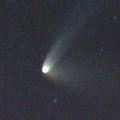
|
It approached to the sun down to 0.3 a.u. on July 6, and brighted up to 3.9 mag (July 6, Thomas Lehmann). Now it is 5.6 mag (July 21, Chris Wyatt). In the Northern Hemisphere, it keeps observable until the comet fades out. It will not be observable after this in the Northern Hemisphere.
Date(TT) R.A. (2000) Decl. Delta r Elong. m1 Best Time(A, h)
July 25 9 58.15 2 15.5 1.197 0.610 30 7.1 20:48 (100,-11)
Aug. 1 10 32.99 -7 39.0 1.249 0.761 37 8.0 20:40 ( 89,-14)
|
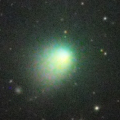
|
Now it is bright as 9.0 mag (July 16, John Drummond). It is expected to brighten up to 5 mag from autumn to winter. It keeps observable in excellent condition until autumn in the Southern Hemisphere. In the Northern Hemisphere, it keeps unobservable until late November.
Date(TT) R.A. (2000) Decl. Delta r Elong. m1 Best Time(A, h)
July 25 23 22.68 -55 39.4 1.266 2.070 129 8.3 3:15 ( 0, 0)
Aug. 1 22 45.45 -63 32.4 1.166 1.978 130 7.9 2:12 ( 0, -8)
|

|
It brightened up to 3.7 mag and became a naked eye comet in mid January (Jan. 13, Marek Biely). Now it is fading. But it is bright as 9.6 mag still now (July 22, Maik Meyer). In the Northern Hemisphere, it keeps observable for a long time until the comet fades out. It is not observable in the Southern Hemisphere.
Date(TT) R.A. (2000) Decl. Delta r Elong. m1 Best Time(A, h)
July 25 15 6.01 61 20.9 2.755 2.741 78 9.7 20:48 (154, 58)
Aug. 1 15 12.40 57 52.9 2.837 2.816 78 9.9 20:40 (147, 59)
|

|
It brightened rapidly. Now it is so bright as 10.4 mag (July 18, Maik Meyer). It keeps 10-11 mag until August. It is observale in good condition in the Northern Hemisphere, but it will be getting lower gradually in the Southern Hemisphere.
Date(TT) R.A. (2000) Decl. Delta r Elong. m1 Best Time(A, h)
July 25 19 51.86 23 46.0 0.771 1.659 136 10.9 23:39 ( 0, 79)
Aug. 1 19 36.41 29 27.3 0.804 1.649 129 10.9 22:56 ( 0, 85)
|
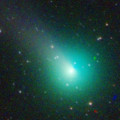
|
It brightened up to 6.0 mag in mid May (May 14, Chris Wyatt). Now it is fading. It has faded down to 9.0 mag in late June (June 21, Marco Goiato). It is not observable now. In the Southern Hemisphere, it will be observable again after September, but the comet will be fainter than 13 mag.
Date(TT) R.A. (2000) Decl. Delta r Elong. m1 Best Time(A, h)
July 25 8 22.63 13 5.4 2.380 1.378 6 11.8 20:48 (125,-22)
Aug. 1 8 26.42 14 1.7 2.480 1.473 5 12.2 3:31 (237,-18)
|

|
Now it is 11.8 mag (July 10, Gabor Santa). It will brighten up to 11 mag autumn. In this apparition, it is observable until the highlight while the comet is brightening.
Date(TT) R.A. (2000) Decl. Delta r Elong. m1 Best Time(A, h)
July 25 13 14.09 -2 53.2 1.747 1.808 76 11.9 20:48 ( 66, 25)
Aug. 1 13 25.89 -4 21.6 1.777 1.775 73 11.8 20:40 ( 67, 23)
|

|
Now it is bright as 10.9 mag (July 19, Sandor Szabo). It will be fading after this. It keeps observable in good condition until winter when the comet becomes fainter than 18 mag.
Date(TT) R.A. (2000) Decl. Delta r Elong. m1 Best Time(A, h)
July 25 2 25.99 10 14.0 1.576 1.784 84 11.8 3:23 (291, 43)
Aug. 1 2 34.83 10 57.3 1.549 1.828 88 12.0 3:31 (296, 49)
|
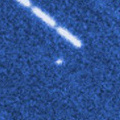
|
It brightened up to 12.8 mag until March (Mar. 21, Michael Mattiazzo). It must have brightened up to 10.5 mag in May and June, but it was not observable. In the Northern Hemisphere, it will be observable after autumn while the comet will be fading.
Date(TT) R.A. (2000) Decl. Delta r Elong. m1 Best Time(A, h)
July 25 7 48.81 31 39.7 2.472 1.501 13 11.9 3:23 (225, -5)
Aug. 1 8 13.50 31 51.3 2.494 1.537 15 12.2 3:31 (227, -4)
|
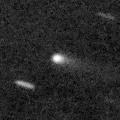
|
Now it is 13.6 mag (July 18, Alan Hale). It will brighten up to 12 mag from August to October. In the Northern Hemisphere, it will be getting higher gradually after July, then it keeps observable in good condition. In the Southern Hemisphere, it keeps low until November.
Date(TT) R.A. (2000) Decl. Delta r Elong. m1 Best Time(A, h)
July 25 5 11.43 22 35.5 1.807 1.265 42 13.0 3:23 (254, 17)
Aug. 1 5 39.95 23 30.9 1.789 1.252 42 12.8 3:31 (254, 19)
|

|
Now it is 12.9 mag (July 11, Gabor Santa). In 2015, it keeps 13-14 mag and will be observable in good condition for a long time.
Date(TT) R.A. (2000) Decl. Delta r Elong. m1 Best Time(A, h)
July 25 19 13.60 -9 48.1 2.621 3.601 162 13.2 23:02 ( 0, 45)
Aug. 1 19 11.62 -10 14.9 2.666 3.620 156 13.2 22:32 ( 0, 45)
|

|
It brightened up to 13.4 mag in outburst on July 11 (John Drummond). It brightened up to 12.3 mag in outburst again on July 23 (Jean-Francois Soulier).
Date(TT) R.A. (2000) Decl. Delta r Elong. m1 Best Time(A, h)
July 25 17 19.62 -30 48.4 5.218 6.023 139 13.4 21:08 ( 0, 24)
Aug. 1 17 17.82 -30 36.3 5.292 6.021 132 13.5 20:40 ( 0, 24)
|
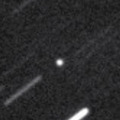
|
Now it is 16.7 mag (July 10, J. Gonzalez). It keeps observable after this while the comet will be getting brighter graudually. It will brighten up to 11 mag from autumn to winter. But it locates low at that time.
Date(TT) R.A. (2000) Decl. Delta r Elong. m1 Best Time(A, h)
July 25 14 12.38 -1 7.9 1.510 1.816 89 14.6 20:48 ( 56, 37)
Aug. 1 14 20.29 -2 50.3 1.537 1.776 85 14.3 20:40 ( 57, 34)
|

|
Now it is 15.1 mag (Apr. 17, Taras Prystavski). It will pass close to the earth from spring to summer in 2016, and it is expected to be observable at 6-7 mag in good condition. In the Northern Hemispehre, it will be getting higher gradually in the morning sky, then it keeps observable in excellent condition until winter. In the Southern Hemisphere, it will be observable after mid August, but it keeps very low until winter.
Date(TT) R.A. (2000) Decl. Delta r Elong. m1 Best Time(A, h)
July 25 5 33.77 35 0.3 4.471 3.731 38 14.5 3:23 (240, 19)
Aug. 1 5 37.01 35 20.1 4.316 3.660 44 14.3 3:31 (243, 25)
|
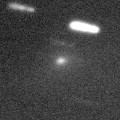
|
Now it is 14.1 mag and visible visually (July 10, Jakub Cerny). Distant object, but it keeps observable at 14-15 mag for a long time from 2015 to 2016.
Date(TT) R.A. (2000) Decl. Delta r Elong. m1 Best Time(A, h)
July 25 21 26.64 -1 9.0 4.427 5.361 154 14.5 1:19 ( 0, 54)
Aug. 1 21 24.53 -1 28.1 4.374 5.341 160 14.5 0:49 ( 0, 54)
|

|
It brightened very rapidly, and brightened up to 13.8 mag (May 11, Sandor Szabo). It is not observable already in the Northern Hemisphere. It will be unobservable in early August also in the Southern Hemisphere.
Date(TT) R.A. (2000) Decl. Delta r Elong. m1 Best Time(A, h)
July 25 10 26.65 0 49.3 4.190 3.438 37 14.7 20:48 ( 95, -6)
Aug. 1 10 35.65 -0 7.9 4.246 3.443 33 14.8 20:40 ( 96, -9)
|
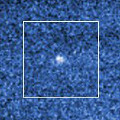
|
Now it is bright as 15.3 mag (July 17, S. Shurpakov). It is expected to brighten up to 15 mag from autum to next spring, and to be observable in excellent condition in the Northern Hemisphere. It keeps unobservable in the Southern Hemisphere.
Date(TT) R.A. (2000) Decl. Delta r Elong. m1 Best Time(A, h)
July 25 2 24.18 45 33.7 2.718 2.635 74 15.1 3:23 (239, 56)
Aug. 1 2 31.32 48 56.2 2.598 2.589 78 14.9 3:31 (231, 60)
|
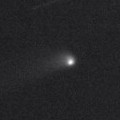
|
Now it is 16.5 mag (July 10, A. Maury, J.-G. Bosch, T. Noel). It will brighten up to 14 mag from 2015 to 2016. It keeps observable in good condition for a while.
Date(TT) R.A. (2000) Decl. Delta r Elong. m1 Best Time(A, h)
July 25 3 13.89 9 20.7 4.376 4.196 73 14.9 3:23 (283, 33)
Aug. 1 3 12.26 9 58.1 4.247 4.191 79 14.9 3:31 (289, 41)
|

|
Now it is 14.8 mag (June 24, iTelescope Observatory, Siding Spring). It keeps 15 mag for a long time from 2014 to 2015. It is observable in excellent condition in the Northern Hemisphere. It locates low in the Southern Hemisphere.
Date(TT) R.A. (2000) Decl. Delta r Elong. m1 Best Time(A, h)
July 25 2 21.93 29 50.8 4.124 4.053 78 15.2 3:23 (266, 54)
Aug. 1 2 23.23 31 26.6 4.039 4.070 84 15.1 3:31 (267, 61)
|

|
It brightened up to 6.9 mag in 2014 autumn (Oct. 17, Marco Goiato). Now it is fading. It has already faded down to 15.9 mag (June 3, K. Hills). In the Southern Hemisphere, it keeps observable in good condition until the comet fades out. In the Northern Hemisphere, it keeps observable until winter, but it locates somewhat low.
Date(TT) R.A. (2000) Decl. Delta r Elong. m1 Best Time(A, h)
July 25 0 35.40 -22 18.6 3.860 4.452 119 15.2 3:23 (343, 31)
Aug. 1 0 28.94 -23 17.3 3.836 4.522 127 15.3 3:31 (354, 32)
|

|
First return of a periodic comet discovered in 1994. Now it is 16.0 mag (June 27, iTelescope Observatory, Siding Spring). It will brighten up to 15 mag from summer to autumn, and will be observable in excellent condition in the Southern Hemisphere. It locates somewhat low in the Northern Hemisphere.
Date(TT) R.A. (2000) Decl. Delta r Elong. m1 Best Time(A, h)
July 25 23 6.74 -34 35.7 1.718 2.576 139 15.3 2:59 ( 0, 21)
Aug. 1 23 6.26 -35 4.5 1.666 2.558 144 15.2 2:31 ( 0, 20)
|
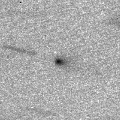
|
Now it is 14.6 mag and visible visually (July 12, Jakub Cerny). It will be observable in excellent condition at 14-15 mag in summer.
Date(TT) R.A. (2000) Decl. Delta r Elong. m1 Best Time(A, h)
July 25 0 22.45 5 2.4 1.153 1.825 114 15.2 3:23 (336, 58)
Aug. 1 0 27.66 5 27.4 1.118 1.846 119 15.3 3:31 (350, 60)
|

|
It keeps 13 mag for a long time from 2015 autumn to 2016 summer. In the Northern Hemispehre, it keeps observable in good condition for a long time. It keeps unobservable in the Southern Hemisphere.
Date(TT) R.A. (2000) Decl. Delta r Elong. m1 Best Time(A, h)
July 25 5 31.96 43 54.0 4.250 3.555 41 15.4 3:23 (232, 23)
Aug. 1 5 40.67 45 20.5 4.133 3.510 46 15.2 3:31 (232, 28)
|
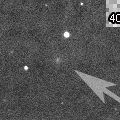
|
Now it is 13.6 mag (June 27, Chris Wyatt). It is getting higher gradually in the morning sky. However, it will be fading rapidly, and will be fainter than 18 mag in late August.
Date(TT) R.A. (2000) Decl. Delta r Elong. m1 Best Time(A, h)
July 25 4 27.52 5 14.7 2.425 2.059 57 15.3 3:23 (275, 16)
Aug. 1 4 39.21 5 5.4 2.409 2.108 60 15.8 3:31 (279, 21)
|

|
It was reported so bright as 14.6 mag visually (July 11, Jakub Cerny). However, it is faint as 16.4 mag by CCD observations (July 18, Ken-ichi Kadota). It was expected to brighten rapidly up to 11 mag from summer to autumn. But actually, maybe it brightens up to 15 mag at best. In the Northern Hemisphere, it keeps observable in good condition in the morning sky. It keeps locating extremely low from summer to autumn.
Date(TT) R.A. (2000) Decl. Delta r Elong. m1 Best Time(A, h)
July 25 3 40.32 36 46.1 0.704 0.920 61 15.8 3:23 (249, 41)
Aug. 1 4 38.88 36 35.9 0.741 0.861 56 15.6 3:31 (247, 36)
|

|
Now it is 16.0 mag (May 26, Yasukazu Ikari). It is observable at 15-16 mag in good condition until autumn. It locates somewhat low in the Northern Hemisphere.
Date(TT) R.A. (2000) Decl. Delta r Elong. m1 Best Time(A, h)
July 25 17 56.11 -24 7.9 7.172 8.047 147 15.9 21:45 ( 0, 31)
Aug. 1 17 51.83 -24 26.7 7.276 8.078 139 15.9 21:13 ( 0, 31)
|

|
It keeps 15-16 mag for a long time until 2016. It keeps observable in excellent condition in the Northern Hemisphere. It keeps unobservable in the Southern Hemisphere.
Date(TT) R.A. (2000) Decl. Delta r Elong. m1 Best Time(A, h)
July 25 4 52.14 48 33.9 5.816 5.216 49 16.0 3:23 (230, 32)
Aug. 1 4 58.51 49 43.3 5.735 5.210 54 16.0 3:31 (230, 36)
|
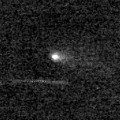
|
Now it is 16.7 mag (July 18, Space Surveillance Telescope, Atom Site). It will be observable at 15 mag in good condition in autumn.
Date(TT) R.A. (2000) Decl. Delta r Elong. m1 Best Time(A, h)
July 25 1 41.46 8 25.8 1.842 2.180 94 16.1 3:23 (304, 50)
Aug. 1 1 51.08 8 54.8 1.758 2.167 99 16.0 3:31 (311, 55)
|

|
It brightened up to 13 mag in 2014. Now it is 16.7 mag (June 3, Taras Prystavski). It will be fading slowly after this. It is observable at 16 mag in excellent condition from summer to winter in 2015.
Date(TT) R.A. (2000) Decl. Delta r Elong. m1 Best Time(A, h)
July 25 1 37.67 2 17.8 3.487 3.765 98 16.1 3:23 (311, 46)
Aug. 1 1 39.81 2 23.2 3.403 3.781 104 16.1 3:31 (321, 51)
|

|
Now it is 19 mag (June 13, WISE). It is expected to brighten rapidly up to 15 mag in August. It is observable in good condition in the Southern Hemisphere. It locates somewhat low in the Northern Hemisphere until August.
Date(TT) R.A. (2000) Decl. Delta r Elong. m1 Best Time(A, h)
July 25 12 58.82 -10 10.9 0.389 0.996 75 16.4 20:48 ( 63, 18)
Aug. 1 13 21.50 -10 33.9 0.346 0.981 74 16.1 20:40 ( 62, 18)
|
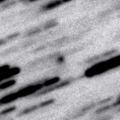
|
It brightened up to 16.4 mag in 2014 (Nov. 14, J. F. Hernandez). Now it is 17.5 mag (June 28, B. Lutkenhoner, M. Kumrucu-Lohmiller, P. Cox). It will be observable at 16 mag again from summer to autumn in 2015. However, it is fainter than this ephemeris recently.
Date(TT) R.A. (2000) Decl. Delta r Elong. m1 Best Time(A, h)
July 25 3 17.23 23 44.8 2.485 2.314 68 16.2 3:23 (267, 40)
Aug. 1 3 28.20 24 31.6 2.430 2.335 72 16.2 3:31 (269, 46)
|

|
First return of a periodic comet discovered in 2008. Now it is 16.8 mag (June 21, J. Nicolas, C. Rinner, F. Kugel, A. Klotz). It approaches to the earth and it is observable at 16 mag in good condition from spring to summer.
Date(TT) R.A. (2000) Decl. Delta r Elong. m1 Best Time(A, h)
July 25 2 28.50 -4 51.3 0.726 1.233 88 16.5 3:23 (305, 33)
Aug. 1 2 48.74 -5 12.3 0.739 1.257 90 16.6 3:31 (308, 35)
|

|
Now it is 16.4 mag (June 12, Takaaki Oribe). It is fading, but it is observable at 17 mag in good condition until late autumn. The fragments B and C are already fainter than 20 mag (June 12, Takaaki Oribe).
Date(TT) R.A. (2000) Decl. Delta r Elong. m1 Best Time(A, h)
July 25 23 37.61 10 7.1 5.481 6.079 121 16.8 3:23 (356, 65)
Aug. 1 23 33.88 9 25.8 5.428 6.124 129 16.8 2:58 ( 0, 65)
|

|
Now it is 16.5 mag (June 3, Taras Prystavski). In the Northern Hemisphere, it is getting higher gradually in the morning sky. In the Southern Hemisphere, it locates extremely low, and will be unobservable in August.
Date(TT) R.A. (2000) Decl. Delta r Elong. m1 Best Time(A, h)
July 25 4 52.87 25 19.5 1.699 1.247 46 16.8 3:23 (254, 22)
Aug. 1 5 17.86 28 0.3 1.694 1.260 47 16.8 3:31 (252, 25)
|

|
First return of a new periodic comet which brightened up to 12 mag in 2009. Now it is 18.3 mag (June 10, Hidetaka Sato), fainter than this ephemeris by 1 mag. It will be 17-18 mag at best in this apparition. It is observable in good condition in the Southern Hemisphere. In the Northern Hemisphere, it keeps locating extremely low after June.
Date(TT) R.A. (2000) Decl. Delta r Elong. m1 Best Time(A, h)
July 25 12 12.37 -10 16.2 1.535 1.450 65 16.9 20:48 ( 71, 9)
Aug. 1 12 34.06 -11 8.1 1.555 1.440 64 16.8 20:40 ( 70, 9)
|

|
Now it is 16.7 mag (June 12, Mitsunori Tsumura). It will be fading after this, and will be fainter than 18 mag in September.
Date(TT) R.A. (2000) Decl. Delta r Elong. m1 Best Time(A, h)
July 25 16 35.18 -6 37.7 0.970 1.763 125 16.9 20:48 ( 9, 48)
Aug. 1 16 42.51 -6 46.8 1.021 1.768 120 17.0 20:40 ( 13, 47)
|
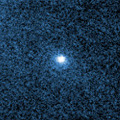
|
Now it is 16.5 mag (June 3, Taras Prystavski). It keeps observable in good condition until the comet fades out. In 2014, it must have been observable at 14 mag in good condition in the Southern Hemisphere.
Date(TT) R.A. (2000) Decl. Delta r Elong. m1 Best Time(A, h)
July 25 0 52.60 0 39.8 3.416 3.870 109 17.0 3:23 (327, 51)
Aug. 1 0 51.90 1 5.3 3.370 3.920 115 17.1 3:31 (340, 55)
|

|
Now it is 16.2 mag (June 21, Space Surveillance Telescope, Atom Site). It keeps observable at 17 mag from spring to summer. It locates somewhat low in the Northern Hemisphere.
Date(TT) R.A. (2000) Decl. Delta r Elong. m1 Best Time(A, h)
July 25 16 37.26 -23 39.8 2.491 3.234 129 17.1 20:48 ( 6, 31)
Aug. 1 16 37.84 -23 19.8 2.577 3.242 122 17.2 20:40 ( 11, 31)
|
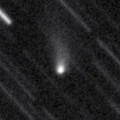
|
It brightened up to 15.3 mag in winter (Jan. 17, Taras Prystavski). Now it is fading. It has already faded down to 17.8 mag (June 3, Taras Prystavski). It keeps observable in good condition for a while. But it will be fainter than 18 mag in September.
Date(TT) R.A. (2000) Decl. Delta r Elong. m1 Best Time(A, h)
July 25 23 39.13 -14 42.7 1.873 2.655 131 17.2 3:23 (357, 40)
Aug. 1 23 20.48 -14 11.6 1.834 2.707 141 17.2 2:45 ( 0, 41)
|
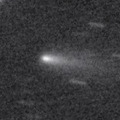
|
It brightened up to 13.9 mag in May (May 14, Chris Wyatt). Now it is fading. It has already faded down to 16.1 mag (July 11, J. Aledo). It will be fainter than 18 mag soon.
Date(TT) R.A. (2000) Decl. Delta r Elong. m1 Best Time(A, h)
July 25 21 26.42 -9 34.3 0.616 1.609 159 17.2 1:19 ( 0, 46)
Aug. 1 21 18.98 -10 38.1 0.654 1.661 168 17.6 0:44 ( 0, 44)
|
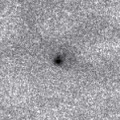
|
It must have brightened up to 11 mag from January to February, but no observations have been reported. Now it is 16.9 mag (July 9, A. Maury, J.-G. Bosch, T. Noel). It will be fainter than 18 mag in late August.
Date(TT) R.A. (2000) Decl. Delta r Elong. m1 Best Time(A, h)
July 25 2 42.45 -9 56.3 2.094 2.280 87 17.3 3:23 (306, 26)
Aug. 1 2 48.13 -10 25.3 2.066 2.333 91 17.4 3:31 (312, 31)
|

|
Now it is 17.7 mag (May 10, A. Maury, J.-F. Soulier). It has brightened in outburst up to 14 mag twice, in 2006 January and 2011 May. It is around the perihelion now. It keeps observable at 17 mag for a long time after this.
Date(TT) R.A. (2000) Decl. Delta r Elong. m1 Best Time(A, h)
July 25 23 29.01 -2 29.4 5.133 5.834 129 17.4 3:21 ( 0, 53)
Aug. 1 23 28.14 -2 37.5 5.058 5.837 136 17.4 2:52 ( 0, 52)
|

|
Now it is 18 mag (July 16, WISE). It is expected to brighten rapidly, and to be observable at 14.5 mag in good condition in autumn.
Date(TT) R.A. (2000) Decl. Delta r Elong. m1 Best Time(A, h)
July 25 2 4.49 -4 33.6 1.530 1.895 94 17.7 3:23 (310, 37)
Aug. 1 2 19.41 -4 25.1 1.436 1.855 96 17.5 3:31 (315, 40)
|
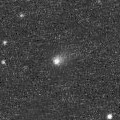
|
It brightened up to 15.3 mag in June (June 21, Space Surveillance Telescope, Atom Site). Now it is fading. It has already faded down to 17.1 mag (July 4, K. Hills). It will be fainter than 18 mag in August. It is observable in excellent condition in the Southern Hemisphere. It locates somewhat low in the Northern Hemisphere.
Date(TT) R.A. (2000) Decl. Delta r Elong. m1 Best Time(A, h)
July 25 16 5.67 -23 26.8 1.961 2.648 122 17.5 20:48 ( 14, 30)
Aug. 1 16 8.53 -23 33.3 2.048 2.659 116 17.6 20:40 ( 18, 29)
|

|
Now it is 17.4 mag (June 14, A. Diepvens). It was observed at 17 mag in 2014 summer. In the Northern Hemisphere, it is observable at 17.5 mag in excellent condition also in 2015. It is not observable in the Southern Hemisphere.
Date(TT) R.A. (2000) Decl. Delta r Elong. m1 Best Time(A, h)
July 25 22 16.96 55 3.8 4.123 4.426 100 17.5 2:09 (180, 70)
Aug. 1 22 13.97 55 5.7 4.097 4.456 104 17.6 1:38 (180, 70)
|

|
Now it is 17.2 mag (June 13, iTelescope Observatory, Siding Spring). It will be observable at 17.5 mag in good condition in summer.
Date(TT) R.A. (2000) Decl. Delta r Elong. m1 Best Time(A, h)
July 25 2 16.73 9 5.2 1.305 1.605 86 17.7 3:23 (295, 44)
Aug. 1 2 31.47 9 28.3 1.272 1.623 89 17.7 3:31 (299, 48)
|
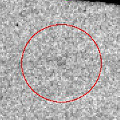
|
Now it is 17.0 mag (June 20, iTelescope Observatory, Siding Spring). First return of a comet re-discovered after 112-year blank in 2008. It brightened up to 12 mag in 2008. In this apparition, it was expected to brighten up to 15 mag from spring to summer, but it is fainter than predicted. It keeps locating low in the morning sky for a while.
Date(TT) R.A. (2000) Decl. Delta r Elong. m1 Best Time(A, h)
July 25 3 19.08 13 40.8 1.748 1.706 70 17.7 3:23 (278, 35)
Aug. 1 3 34.16 13 31.1 1.721 1.737 73 17.8 3:31 (281, 39)
|

|
It keeps 16 mag for a long time from 2015 autumn to 2016 summer. It keeps observable in excellent condition in the Southern Hemisphere. It locates low in the Northern Hemisphere.
Date(TT) R.A. (2000) Decl. Delta r Elong. m1 Best Time(A, h)
July 25 3 25.67 -2 18.5 3.457 3.329 74 17.9 3:23 (291, 24)
Aug. 1 3 25.50 -3 50.0 3.286 3.285 81 17.7 3:31 (299, 29)
|

|
Far object. Now it is 16.7 mag (July 17, J. Jahn). It keeps observable at 18 mag in good condition from summer to autumn.
Date(TT) R.A. (2000) Decl. Delta r Elong. m1 Best Time(A, h)
July 25 19 52.95 -3 2.4 5.562 6.538 162 17.9 23:41 ( 0, 52)
Aug. 1 19 50.92 -3 25.5 5.571 6.537 160 17.9 23:12 ( 0, 52)
|
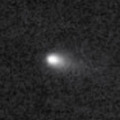
|
It brightened up to 15.9 mag in June as predicted (June 23, Ken-ichi Kadota). It was expected to be observable at 13 mag in good condition from summer to autumn. However, Jean-Gabriel Bosch detected the comet became disintegrating in July. Now it is so faint as 18.7 mag (July 13, Jean-Gabriel Bosch). The fragment D was also observed at 21.9 mag in May (May 30, Pan-STARRS 1).
Date(TT) R.A. (2000) Decl. Delta r Elong. m1 Best Time(A, h)
July 25 1 18.82 -0 9.5 1.161 1.709 103 18.2 3:23 (319, 47)
Aug. 1 1 31.68 0 40.2 1.108 1.703 106 18.0 3:31 (326, 50)
|
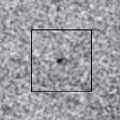
|
Now it is 18.9 mag (July 13, A. Maury, J.-G. Bosch, T. Noel, J.-F. Soulier). It was expected to brighten rapidly, and to be observable at 16 mag in good condition from summer to winter. But actually, it is much fainter than predicted.
Date(TT) R.A. (2000) Decl. Delta r Elong. m1 Best Time(A, h)
July 25 23 37.45 -14 53.1 1.769 2.559 131 18.8 3:23 (358, 40)
Aug. 1 23 36.52 -14 35.5 1.674 2.523 138 18.6 3:01 ( 0, 40)
|
|
![]()
 57P/du Toit-Neujmin-Delporte
57P/du Toit-Neujmin-Delporte C/2014 W2 ( PanSTARRS )
C/2014 W2 ( PanSTARRS ) 6P/d'Arrest
6P/d'Arrest 141P/Machholz 2
141P/Machholz 2 C/2010 S1 ( LINEAR )
C/2010 S1 ( LINEAR ) C/2013 V4 ( Catalina )
C/2013 V4 ( Catalina ) 61P/Shajn-Schaldach
61P/Shajn-Schaldach 117P/Helin-Roman-Alu 1
117P/Helin-Roman-Alu 1 320P/2015 HC10 ( McNaught )
320P/2015 HC10 ( McNaught ) 44P/Reinmuth 2
44P/Reinmuth 2 319P/2015 G1 ( Catalina-McNaught )
319P/2015 G1 ( Catalina-McNaught ) C/2011 J2 ( LINEAR )
C/2011 J2 ( LINEAR ) 162P/Siding Spring
162P/Siding Spring 325P/2015 J4 ( Yang-Gao )
325P/2015 J4 ( Yang-Gao ) 221P/LINEAR
221P/LINEAR C/2015 K1 ( MASTER )
C/2015 K1 ( MASTER ) 299P/2014 D2 ( Catalina-PanSTARRS )
299P/2014 D2 ( Catalina-PanSTARRS ) C/2014 AA52 ( Catalina )
C/2014 AA52 ( Catalina ) 218P/LINEAR
218P/LINEAR 7P/Pons-Winnecke
7P/Pons-Winnecke 174P/(60558) 2000 EC98 ( Echeclus )
174P/(60558) 2000 EC98 ( Echeclus ) 230P/LINEAR
230P/LINEAR P/2015 F1 ( PanSTARRS )
P/2015 F1 ( PanSTARRS ) C/2013 G3 ( PanSTARRS )
C/2013 G3 ( PanSTARRS ) 220P/McNaught
220P/McNaught 205P/Giacobini
205P/Giacobini C/2014 W5 ( Lemmon-PanSTARRS )
C/2014 W5 ( Lemmon-PanSTARRS ) C/2012 LP26 ( Palomar )
C/2012 LP26 ( Palomar ) 51P/Harrington
51P/Harrington 50P/Arend
50P/Arend![]()











































